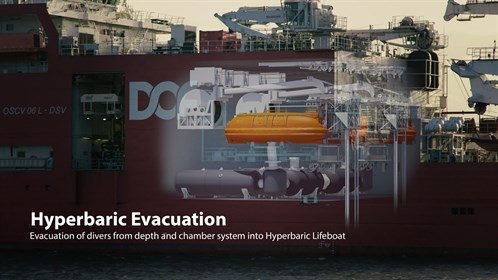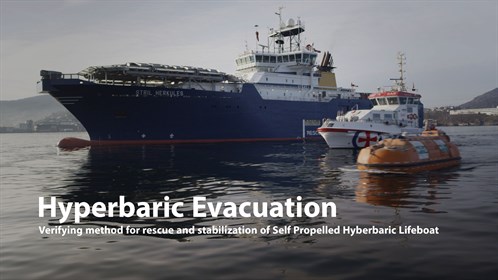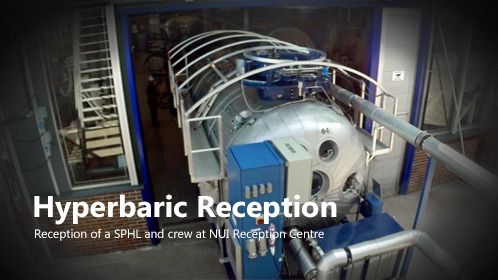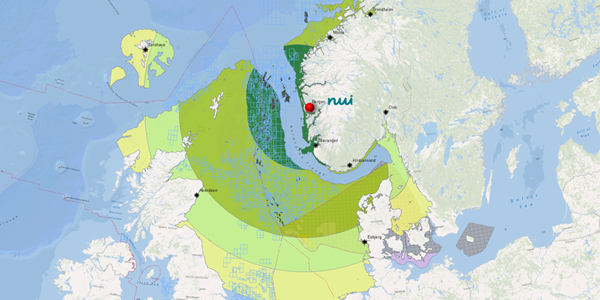
Hyperbaric Reception Facility (HRF)
Hyperbaric Rescue Facility for Self Propelled Hyperbaric Lifeboat (SPHL):
Our Hyperbaric Rescue Facility(HRF) covers the Norwegian, Danish and majority of UK sector and has capacity for 24men in saturation. Our robust alignment table is designed and produced to fit the largest Self Propelled Hyperbaric Lifeboats (SPHL) in operation today and in the future. The table is established on the quayside with connection to the in-house chamber system. This reduces the handling of the SPHL and involved risks.
A mobile rescue chamber is used for transfer of divers from SPHL to the NUI in-house chamber system. In case of emergency, this rescue chamber will be used for evacuation of divers out from the in-house chamber complex. NUI also have an extra Life Support Package(LSP) to supply a second lifeboat while the other SPHL is on the alignment table.
NUI has upgraded their saturation system with the latest Fathom Systems DMS, Analysers and communications.
In the spring and summer of 2014 Rapid Response Rescue Vessel trials picking up a Self Propelled Hyperbaric Lifeboat were performed for the first time ever as a joint program between Statoil, Technip, Subsea7 and NUI.
The films shown under is from the three different phases of Hyperbaric Rescue:
Hyperbaric Evacuation – Phase 1
Hyperbaric Evacuation – Phase 2
Hyperbaric Evacuation – Phase 3
Phase 1 (Evacuation from Vessel)
The diving industry recognize that during a ship catastrophic failure where the ship must be abandoned – typically due to a collision, grounding, uncontrolled fire, explosion, capsized or sinking vessel, there must be proven evacuation methods for all personnel onboard.
Onboard a Dive Support Vessel successful methods to rescue divers under pressure requires good planning and equipment in order to get divers safely back to surface in an emergency situation where the Diving Support Vessel has to be abandoned.
Very few hyperbaric evacuations have ever taken place, however it is recognised that there has been incidents where proper hyperbaric evacuation systems were not actually available. It is also well know that vessels do have to be abandoned from time to time.
There are several phases in a sustainable hyperbaric rescue plan and up to date competence and skills are essential for a successful outcome of a rescue situation. A complete evacuation should not take more than 30 minutes.
This video is a joint project between Statoil and Technip recorded on board the Technip Dive Support Vessel Skandi Arctic.
Phase 2 (Recovery of SPHL)
The diving industry recognize that during a ship catastrophic failure where the ship must be abandoned – typically due to a collision, grounding, uncontrolled fire, explosion, capsized or sinking vessel, there must be proven evacuation methods for all personnel onboard.
For saturation divers Self Propelled Hyperbaric Lifeboats has been implemented to ensure safe evacuation of divers living under elevated pressure conditions.
Statoil as offshore Operator of several oil and gas fields utilizing diving services have introduced 3 Rapid Response Rescue Vessel’s, RRRV’s, as part of their contingency & rescue plan for all personnel on their fields; including rescue of saturation divers.
In the spring and summer of 2014 Rapid Response Rescue Vessel trials picking up a Self Propelled Hyperbaric Lifeboat were performed for the first time ever as a joint program between
Statoil, Technip, Subsea7 and NUI
Phase 3 (Reception of SPHL and crew at NUI HRF)
The diving industry recognize that during a ship catastrophic failure where the ship must be abandoned – typically due to a collision, grounding, uncontrolled fire, explosion, capsized or sinking vessel, there must be proven evacuation methods for all personnel onboard.
For saturation divers Self Propelled Hyperbaric Lifeboats has been implemented to ensure safe evacuation of divers living under elevated pressure conditions. Phase 3 of the evacuation cover the onshore reception after a SPHL has arrived with personnel onboard.




